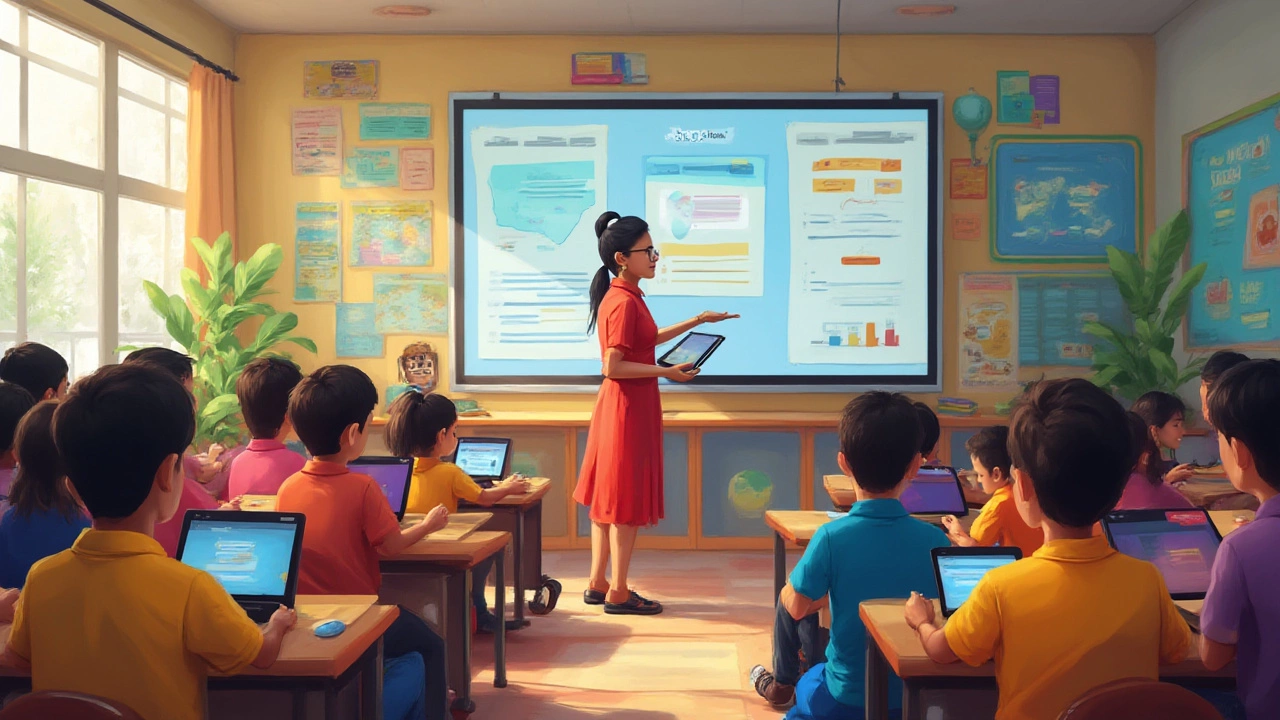Ever wondered how teachers are juggling dozens of assignments, discussions, and grades online without drowning in chaos? Google’s education platform is quietly running the show in classrooms from Delhi to Detroit, making online learning feel — dare I say — almost easy. Instead of the old-school paper trail and endless email chains, teachers and students are clicking into a virtual hub where lessons, chats, quizzes, grades, and collaboration land in one neat digital folder. Sounds slick, but what really lies behind the familiar Google logo, and why are nearly 150 million students and educators worldwide logging in every day?
What Is Google’s Education Platform and Where Does It Fit In Modern Learning?
First things first — when people say "Google education platform," most are talking about a bundle of tools, but the big star is Google Classroom. It's the heart of their education suite designed to make teaching and learning more organized, interactive, and manageable, no matter if you’re in a physical classroom, learning from home, or caught somewhere in between.
Google launched Classroom in 2014 after teachers kept hacking basic consumer Google tools — Drive, Docs, and Gmail — to share homework and resources. They needed something built for schools, and Google got the memo. So, they designed Classroom to let teachers create virtual “classes” where students join with a code, see all their stuff in one stream, and turn in assignments digitally. Now, as of 2025, it's not just a fancy Dropbox. It’s hooked into Google Drive, Calendar, Docs, Slides, Sheets, Meet (for video calls), and even Jamboard for whiteboarding.
Here’s what the Google education package usually includes:
- Google Classroom – assignment management, announcements, and grading.
- Google Meet – real-time video for lessons and virtual office hours.
- Docs, Sheets, Slides – collaborative work and real-time document editing.
- Google Forms – quick quizzes, surveys, auto-graded tests.
- Google Drive – super organized online file storage for every class.
- Google Sites – simple tools to build class websites or student portfolios.
- Admin Console – for IT folks to set policies, add users, and automate safety.
Education Week reported in early 2024 that over 70% of US K-12 districts rely on Google Classroom. That's serious market share. And the appeal isn't just about tech for tech’s sake. This stuff is free for schools and packs in features you’d typically pay big money for elsewhere.
A lot of Indian school systems coming online post-pandemic grabbed Google’s education suite because it plays nice on cheap Chromebooks, runs on slow WiFi, and supports 100+ languages. Google even cut special deals in some developing regions to help drive remote learning when schools had to shut down.
The Google education platform fits best for schools looking to ditch endless paperwork, give easy access to materials, and keep communication sharp between teachers, students, and parents. But it’s battling some heavy hitters — Microsoft, Canvas, and Zoom all want a piece of this classroom action.
| Platform | Year Launched | Global Active Users (2025) | Popular Features |
|---|---|---|---|
| Google Classroom | 2014 | ~150 million | Assignment management, Meet, Docs integration |
| Microsoft Teams for Education | 2017 | ~75 million | Assignments, OneNote, immersive reader |
| Canvas LMS | 2011 | ~30 million | Grading, modules, quizzes |
What stands out with Google’s platform is how it bundles familiar, simple tools under one login — no learning curve shock for teachers or students. Logging in with a school email unlocks a whole ecosystem. It all feels pretty seamless, especially if you’ve ever used a Google product before.

Key Features and Day-to-Day Benefits for Teachers and Students
What makes the Google education platform a go-to in so many classrooms? A lot boils down to making life easier for teachers and students, starting with mind-blowing simplicity. There’s no wrestling with clunky logins or mystery menus — after registration, students receive a class code, and boom, they’re inside. Teachers post assignments, pop up Google Forms quizzes, drop in YouTube links, and everything arrives in a long, scrollable feed that’s always up to date.
Here are some standout perks and features, as used in real classrooms across the globe:
- Automatic organization: All files (assignments, submitted work, resources) get sorted into clearly labeled Google Drive folders. Teachers don’t need to keep messy email chains or worry about lost papers.
- Paperless grading: Teachers can comment on essays and grade work directly in Docs or Slides. They save hours per week — one survey from 2023 said teachers save an average of 3-4 hours per week just on grading admin using Google’s tools!
- Real-time collaboration: Multiple students can co-edit documents in real-time, even from different countries. Group projects don’t require texting, emailing files, or fighting over versions.
- Easy parent communication: With Guardian Summaries, parents get weekly email updates about missing work, upcoming deadlines, and classroom announcements. No more "I forgot to tell you" from teens.
- Personalized learning: The platform lets teachers send different tasks to groups or individuals. If one student needs extra math practice, it’s easy to schedule just for them.
- Mobile-friendly: There’s a Classroom app for Android and iOS, so kids with shared family devices or older smartphones aren’t left out. Assignments and feedback follow them wherever they go.
- Quizzes and instant feedback: Google Forms can auto-grade quizzes and quizzes show up in the Classroom feed. Students get quick results, and teachers spot problem areas without manual work.
- Seamless video lessons: With Google Meet, you can launch a video call right from the Classroom, record lessons, and share the link for absent students to catch up later.
- Accessibility: Tools like voice typing in Docs, screen reader support, and translation features all make life easier for kids with diverse learning needs or those working in mixed-language environments.
One cool story: a school district in Texas reported that after moving to Google Classroom, assignment submission rates jumped by 25%. Why? Fewer lost papers, clearer deadlines, and kids could check their work anytime from their phones.
The platform isn’t just about making old paper routines digital. It actually helps invent new ways to teach. Teachers can bring in guest speakers on Meet, host debate contests in Docs, or run real-time polls during lessons. And students who are shy in class often open up in online settings, showing another side of themselves through digital collaboration. Google even built in AI features (as of 2025) that help flag plagiarism and suggest resources based on assignment topics — smart move, since digital classrooms come with new challenges.
Of course, it’s not all rainbows. Teachers have to keep an eye on screen fatigue. Some kids struggle with distractions at home or in busy digital environments. Privacy matters too: even though Google insists it doesn’t mine education data for ads, schools should review what’s getting shared. The upside? Kids are building real-world digital skills just by using these tools every day, which is exactly what future employers want.
Want a few quick tips for getting the most out of Google Classroom?
- Use “Topics” to neatly organize each week or unit. No more endless scrolling for last Monday’s lesson.
- Publish assignments with clear due dates and times — it shows up in students’ Google Calendars automatically.
- Take advantage of Comments — both private (between teacher and student) and class-wide for discussions.
- Try “Reuse Post” to clone assignments or announcements and save time each year.
- Connect third-party apps for flashcards (Quizlet), math practice (Khan Academy), or interactive slides (Pear Deck).
The more teachers and students lean into these features, the smoother remote, hybrid, or in-person learning can go. It’s not about replacing teachers — it’s about giving them superpowers to reach and teach more efficiently.

Future Trends, Limitations, and Practical Advice for Schools Adopting Google’s Tools
With Google’s education platform powering so many classrooms, what’s next? In 2025, there’s big momentum around AI-driven tools, personalized learning, and even virtual reality popping up in lesson plans. Google has been beefing up its AI in Classroom to provide more smart grading, plagiarism checks, and even personalized suggestions for teachers on how to motivate students who might be slipping. This isn’t science fiction — if a student hasn’t turned in several assignments, the platform can now nudge the teacher to send a gentle reminder or suggest helpful resources.
Teachers are also getting new analytics dashboards, not just raw grade books — we’re talking at-a-glance views into which students are active, who needs extra help, and which topics are tripping up the most learners. Schools love this—the days of poring over individual records are gone. At the same time, Google’s Chromebooks and the Classroom app ecosystem now support stylus input, handwriting, and drawing, which is a game-changer for math teachers and kids who think better with a pen.
But, yes, there are a few catches to keep in mind. Privacy watchdog groups keep a close eye on Google’s platforms in education, and parents might have concerns about what happens to kids’ data. Google says it never sells student data or shows ads in education accounts, but schools should always review their privacy agreements. And while Google Classroom packs a ton of features for free, some deeper analytics, integrations, or security tools require the for-pay Google Workspace for Education Plus upgrade. Still, the basic platform covers nearly every school’s must-have list for zero cost, which keeps it popular in budget-conscious districts.
What if your school is considering making the switch? Here are a few tips from real teachers who’ve made the leap:
- Start by setting up a few demo classes and inviting teachers to try posting fake assignments. Hands-on beats any formal training.
- Encourage teachers to share tips with each other, not just rely on official manuals. The best hacks come from the trenches.
- Make sure students and parents have a clear guide on how to log in, check for new work, and ask for help if they’re stuck.
- Check if your school has solid WiFi — laggy connections can slow down assignments and upload times, especially with big projects or video files.
- If your district is big, don’t forget to set “roles” so only teachers manage the classes, and students aren’t making their own classrooms left and right.
The Google education platform is a real-time bridge from the old world of paperwork and lectures to today’s connected, always-on classrooms. It’s not perfect — nothing in EdTech is — but it’s set a global standard that’s tough to beat. Teachers have more time for actual teaching, students can keep up with clear feeds and reminders, and parents are finally in the loop. In a world where education keeps shifting, Google’s tools help everyone keep pace, whether you're learning from a crowded city flat or a rural hilltop school with patchy internet.
One last bit: as other companies try to catch up, expect to see even more features, smarter automation, and tighter integration with the next wave of learning tools. For now, if you’re in a classroom anywhere in the world, there’s a good chance Google is there, quietly making tomorrow’s education a little more possible today.






Write a comment: